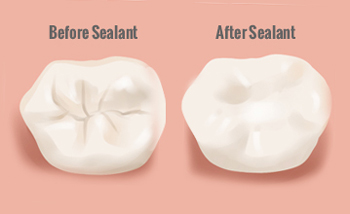| What Is It? |
| A sealant is a clear or tinted plastic protective coating for teeth. It is painted onto the chewing surfaces of the back teeth (molars and premolars). These are the areas where most cavities form. Molars and premolars have grooves and crevices. Dentists call these pits and fissures. Food can get stuck in these crevices. Some are so deep that the bristles of a toothbrush can’t reach into them. Grooves and crevices provide the perfect environment for bacteria to grow and cause cavities. Sealants help to prevent this from happening. They cover the grooves and crevices so that food cannot get into them. |
What It’s Used For?
Sealants are applied to teeth to help prevent cavities. In the past, they usually were used only in children. But adults also can get sealants.
Not only are sealants very effective, they cost a lot less than filling cavities.
In children, sealants can be applied to baby molars to protect them from cavities. Eventually, these molars fall out and the new, permanent molars come in. These molars can be sealed, too. Most dentists recommend that sealants be applied to each permanent molar as soon as possible. This can be when the tooth is only partially erupted into the mouth. However, it can be done only if the tooth can be kept dry and free of saliva while the sealant is applied.
If your child has a high risk of cavities, your dentist may decide to seal the premolars, or bicuspids, as well. The premolars are the teeth directly in front of the molars.
Sealants can be used in adults who have an increased risk of developing cavities. Your dentist can suggest whether sealants are appropriate for you.
Sealants can be put on teeth that show early signs of decay. But once the decay has broken through the enamel, the tooth will need a filling.
Preparation
Applying sealants is quick and painless. It can be done during a routine dental visit. No injections are needed. However, it is very important to sit still so the tooth or teeth being worked on will stay dry. This allows the sealant material to stick properly to the tooth.
How It’s Done
The dentist cleans the area to remove any food or debris in and around the teeth. Then he or she makes sure the teeth are dry so that the sealant can stick. The sealant is applied in liquid form. It flows over and into the grooves and crevices. The sealant usually hardens (sets) within 20 to 60 seconds. Sometimes it is set with a special light.
Follow-Up
| Studies show that sealants can last a long time, sometimes as long as 15 years. But they don’t last forever. The dentist will check the sealants during routine visits. If necessary, the sealants can be replaced. Remember, sealants work well, but they can’t keep teeth cavity-free without some help. Keep brushing twice a day, flossing at least once a day, and visiting a dentist regularly. Children with sealants still should:
|
Risks
Although it is rare, sealants can cause problems in people who are allergic to plastics or components of plastics. There has also been some concern about the possible harmful effects of bisphenol A (BPA). This chemical is found in some sealants. However, studies show that any release of BPA from sealants is very small and limited to the time right after they are applied. The American Dental Association and the U.S. Food and Drug Administration have found that sealants are safe.
When To Call a Professional
Ask your dentist to talk with you about the benefits of sealants. Most pediatric dentists (dentists who specifically treat children) use sealants routinely. However, not all dentists do so. Therefore, your dentist may not think to talk with you about them.


